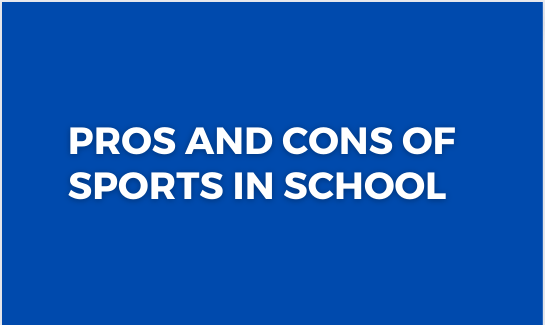Sports in schools are a fundamental part of the educational experience, fostering physical fitness, teamwork, and character development among students. The inclusion of sports in school curricula promotes holistic development by instilling values of perseverance, discipline, and sportsmanship in young individuals. Here are pros and cons of sports in school:
Pros:
- Physical Fitness: Sports promote physical fitness and help students develop healthy habits.
- Teamwork Skills: Students learn the importance of teamwork, collaboration, and cooperation.
- Discipline and Time Management: Sports teach discipline and time management skills as students balance academics and practice.
- Self-Confidence: Sports can boost self-confidence and self-esteem as students achieve personal and team goals.
- Leadership Development: Students have opportunities to develop leadership skills and take on leadership roles within teams.
- Social Interaction: Sports provide a platform for social interaction and the development of friendships.
- Stress Relief: Engaging in sports can serve as a stress reliever and outlet for physical and emotional well-being.
- Goal Setting: Sports help students set and work towards achieving both short-term and long-term goals.
- Improved Concentration: Regular physical activity through sports can enhance focus and concentration in academic settings.
- Character Building: Sports instill values such as perseverance, resilience, and sportsmanship.
- Physical Coordination: Students develop and improve their motor skills and physical coordination through sports.
- Healthy Lifestyle Choices: Sports promote healthy lifestyle choices, including proper nutrition and regular exercise.
- Academic Performance: Engaging in sports can positively impact academic performance through improved focus and time management skills.
- Inclusivity: Sports provide opportunities for students of different backgrounds and abilities to participate and excel.
- Community Engagement: Sports foster a sense of community and school spirit among students, families, and the broader community.
- Emotional Well-being: Participating in sports can contribute to improved mental health and emotional well-being.
- Respect for Authority: Sports teach students to respect authority figures such as coaches and referees.
- College and Scholarship Opportunities: Exceptional sports performance can lead to college scholarships and future athletic opportunities.
- Healthy Competition: Sports introduce healthy competition, teaching students to strive for personal and team excellence.
- Long-Term Health Benefits: Regular participation in sports can contribute to lifelong physical fitness and health.
Cons:
- Time Commitment: Sports can demand significant time commitments, potentially impacting academics and other extracurricular activities.
- Injury Risk: Participating in sports increases the risk of injuries, which can range from minor to severe.
- Academic Pressure: Balancing sports and academics can create additional academic pressure and stress for student-athletes.
- Limited Focus on Other Interests: Extensive involvement in sports can limit students’ ability to explore other interests and hobbies.
- Exclusion and Favoritism: Sports teams may inadvertently foster exclusion or favoritism among students.
- Financial Burden: Costs associated with sports participation, such as equipment, uniforms, and travel, can create financial burdens for some families.
- Conflict with Academic Schedule: Sports events and practices may conflict with class schedules and academic commitments.
- Burnout: The intense demands of sports can lead to physical and mental burnout in student-athletes.
- Limited Participation Opportunities: Not all students may have equal access to sports programs or be able to participate due to tryouts or limited team spots.
- Pressure to Excel: Sports can create pressure for students to excel, potentially leading to unhealthy levels of stress and anxiety.
- Influence on Peer Relationships: Students’ social circles may be influenced by their involvement in sports, potentially affecting friendships.
- Gender Inequality: Some sports programs may not provide equal opportunities or resources for male and female athletes.
- Academic Neglect: Excessive focus on sports can lead to neglect of academic responsibilities and potential decline in grades.
- Loss of Free Time: Student-athletes may have limited free time for relaxation, hobbies, or spending time with family and friends.
- Pressure from Coaches and Parents: The pressure to perform well in sports may come from coaches, parents, or external expectations.
- Overemphasis on Winning: A strong emphasis on winning in sports can overshadow the values of sportsmanship and personal growth.
- Conflict with Personal Identity: Some students may feel pressured to conform to certain athletic identities, which may not align with their personal interests or identity.
- Unhealthy Competition: Sports can lead to unhealthy competition, including cheating, aggression, or unethical behavior.
- Social Comparison and Body Image: Sports participation can lead to heightened social comparison and body image concerns among students.
- Academic Consequences: Falling behind academically due to sports commitments can have long-term consequences for students’ educational goals.
Pros
- Physical Fitness
- Teamwork Skills
- Discipline and Time Management
- Self-Confidence
- Leadership Development
- Social Interaction
- Stress Relief
- Goal Setting
- Improved Concentration
- Character Building
- Physical Coordination
- Healthy Lifestyle Choices
- Academic Performance
- Inclusivity
- Community Engagement
- Emotional Well-being
- Respect for Authority
- College and Scholarship Opportunities
- Healthy Competition
- Long-Term Health Benefits
Cons
- Time Commitment
- Injury Risk
- Academic Pressure
- Limited Focus on Other Interests
- Exclusion and Favoritism
- Financial Burden
- Conflict with Academic Schedule
- Burnout
- Limited Participation Opportunities
- Pressure to Excel
- Influence on Peer Relationships
- Gender Inequality
- Academic Neglect
- Loss of Free Time
- Pressure from Coaches and Parents
- Overemphasis on Winning
- Conflict with Personal Identity
- Unhealthy Competition
- Social Comparison and Body Image
- Academic Consequences


